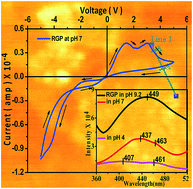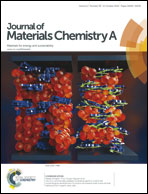On the pH sensitive optoelectronic properties of amphiphilic reduced graphene oxide via grafting of poly(dimethylaminoethyl methacrylate): a signature of p- and n-type doping†
Abstract
Poly(N,N′-dimethylaminoethyl methacraylate) (PDMAEMA) functionalized reduced graphene oxide (rGO) is synthesized by atom transfer radical polymerization, followed by attachment to rGO via diazonium coupling. The rGO-PDMAEMA (RGP) is characterized by 1H NMR, UV-Vis, FTIR and Raman spectroscopy. TEM and AFM studies demonstrate the formation of molecular brushes of PDMAEMA chains over rGO surface, and the TGA thermograms indicate 55 wt% grafting of PDMAEMA. RGP is dispersible in the widest spectrum of solvents from CCl4 to water [solubility parameter (δp + δh), 0.6 to 58]. RGP exhibits strongly pH dependent fluorescence properties: at pH 4, it exhibits two emission peaks, but at pH 7 and pH 9.2, a single and broad emission peak is observed. Two emission peaks at pH 4 are attributed to radiative decay of excitons to two kinds of holes in the rGO originating from illumination and p-type doping, which is also characterized by a blue shift of the Raman D band. Moreover, n-type doping of RGP at pH 9.2 is also evident due to a similar Raman shift. The dc-conductivity of RGP at pH 4 is 2 orders higher than that of pH 9.2 and the I–V characteristic curve at pH 7 exhibits a bimodal NDR property with a rectification ratio of 5.5. The bimodal NDR property is explained with a model using density of states and polaronic band.


 Please wait while we load your content...
Please wait while we load your content...